Stunning '82 GS1100GZ GS-spclist nut-bolt level freshening of 1-owner 10k exmple
1982 Suzuki GS
| Price: | US $4,000.00 |
| Item location: | Akron, Ohio, United States |
| Make: | Suzuki |
| Model: | GS |
| SubModel: | 1100GZ |
| Type: | Naked |
| Year: | 1982 |
| Mileage: | 10,848 |
| VIN: | js1gu71g0c2101663 |
| Color: | Black |
| Engine size: | 1,100 |
| Vehicle Title: | Clear |
| Contact seller: | Contact form |
About the SellerAkron Suzuki Works is a 2-bay GS-specialty shop. Our crew includes a mechanical engineer. a dealership trained Suzuki mechanic and some nut-bag GS enthusiasts who like to see sweet-looking vintage GS's put back into primo riding shape. We have built and tuned just about everything GS. We have particular expertise in carb tuning and modification. suspension tuning. charging and electrical systems. We do concourse Suzuki restorations for clients--for example see the GS Resources Aug 2010 Bike of the month: http://www. thegsresources. com/botm. php?year=2010&month=8 Iím particularly careful to provide accurate descriptions as we have sent bikes and parts to Europe. Canada. South America and all over the US--I know buyers donít like surprises. We offer 12 yrs of eBay feedback as our best reference. We're suffering through a very tough winter here so I'm hoping a bit of GS eye-candy will brighten up everybody's outlook! It's a pleasure to present this pristine. 2-owner GS1100GZ example. We were able to save most of its lovely factory paint while giving it a very thorough update mechanically. electrically and cosmetically. For those of you who follow ASW auctions. you know that we take Suzuki GS restorations very seriously--that is basically all we do. We have done over 60 GS restorations over the past few years and have sent bikes all over the US as well as France. Ireland. even back to Japan. You can expect an ASW restored bike to perform at least as well as when it was new and typically it will be more reliable than it was in the day since we incorporate service bulletins issued over the years plus our own list of improvements. It is very unusual to find a 35 yr old vehicle still with the original owner and even more unusual for a 1982 GS not to have been ridden until 1986 but both are the case with this G. It stayed with the Suzuki dealer until it was sold to it's first owner in 1986! This auction bike is pure pleasure to ride. It is tuned with a high-flow air filter and a slight reduction in exhaust baffling while preserving the OE exhaust system. The engine is a very strong running example of a basically stock motor--no cam degreeing. no Wiseco kit. no header. We do a few things to improve cold starting. Slightly richening the choke circuit along with the fitment of the amazing Shorai Lithium battery (shoraipower dot com) lights this G up instantly in any ambient temperature you care to tackle. These batteries weigh a couple pounds (vs about 10 lbs for a lead acid battery) and will provide nearly full voltage to the starter motor after sitting for months without tending. The mid-range performance is spot-on thanks to needle-height shimming in the absence of a jet kit. The 4 carb slides take off in unison at the slightest throttle twist and keep right at it to peak hp at 8. 00 rpm but. with 66 ft-lb of torque showing up at 6500 rpm. I say stop twisting right there and enjoy the ride. The close-to-stock OE exhaust system provides a subdued rumble that will put a smile on your face--lovely and sweet to hear. We take handing very seriously around here also. While the forks were getting new seals the valving got it's first solvent bath in 30 yrs. We fitted a set of progressive springs (progressivesuspension dot com) and upgraded to 20 wt oil which we have found slows front end dampening down just enough to make wide sweepers or downhill twisty corners something to be enthusiastically embraced. As GS buffs know. the forks air pre-load system controls the adjustment of static sag. This bike has nearly ideal static sag of 24mm at about 12 psi. The 'drop-down' of the bike (as the rider settles into the saddle with the bike at rest) is about the same at the front end and back end. The dash display includes a bright red gear position indicator. unusual for the day. Non-GS-ers laugh about how 'you should know what gear you're in'. Maybe. but I tell them on an 1100 it almost doesn't matter since you can take off smoothly in second or third and accelerate smoothly from 50 to illegal in 3rd. 4th or 5th. It is handy in the event of a sudden stop to see what gear you happen to be in. We don't overuse the 'like new' description but you can expect maintenance going forward to be the same as for a new bike. Oil change or two a year. check drive case levels. tire pressure. filter conditions. nbsp; etc. Get on this bike and enjoy it and appreciate the history that produced such quality machinery. Lots of details below about this very special GS. Also included is our check-list for what it takes to get a GS ready for it's 'next 30 years. ' Thanks for looking at our auction and if this isn't the GS of your dreams. tell us what you're looking for and we may be able to put one together for you! More photos at high resolution can be found on our photo server at: http://suzuki-gs-bikes. smugmug. com/Motorcycles/8-valve-examples/Unbelievable-1982-GS1100G-1/ A NOTE ABOUT PRICING Thanks to the internet. pricing is pretty transparent these days. Everybody knows what everything sells for. We cannot compete on price against Craig's list specials. But fortunately for us (and you) sellers of those bikes can't compete with us on GS knowledge and quality of workmanship. It takes many hours of skilled labor to get a vintage GS into the condition of this auction bike and we have to recover those costs to keep the lights on here at the shop. It is getting harder to find a good starting point for a GS restoration. Since these bikes are still being ridden. the pool of nice low-mile originals gets smaller every year--and the acquisition cost of good restoration candidates goes up as well as the cost of parts and labor to sort them out. This is what we cover in our re-newal process FORKS. BARS. LEVERS. SWITCHES. CABLES Fork seals -replace Fork tubes polish small pits Fork springs-replace with progressive springs from progressive. com Throttle cable-replace Brake lever. check/replace. lube pivot clutch lever. check/replace. lube pivot service or replace brake switches tach drive-replace shaft seal tach cable-replace All other switches (check. repair or replace as required) ENGINE re-torque head bolts Cam box gasket. seals-replace Adjust valve clearance-replace shims as required All other gaskets (replace as required): Clutch cover. Stator cover. CDI cover Fiber clutch plates (replace with Suzuki OE as required) Change Oil. replace filter (Suzuki OE filter) 4 qts Castrol 10-40 MC oil TRANS & FINAL DRIVE Check sprockets Clean. adjust chain R&R rear wheel. nbsp; check rear wheel bearings BRAKES Flush/clean resovoirs (this one got the front MC replaced) Inspect/rebuild calipers as reqd front pads-replace rear pads-replace bleeders. caps-replace brake lines inspect/replace as required EXHAUST remove & detail replace 4 exhaust port seals CARBS Remove. disassemble. bead blast bowl's. soak and clean passages Rejet to improve midrange Repace pilot jet plugs. o-rings. gaskets as required Replace air filter drill choke pick-ups to improve cold starting polish #1. #4 float bowl and vacuum covers replace #1. #4 cover fasteners w nos replace airbox intake tubes and clamps adjust low speed idle F/A screws adjust vacuum to synch carbs test ride between steps on jetting TANK. BODYWORKS. CHASSIS drain. flush tank. inspect for corrosion. re-line if required rebuild/replace petcock as required Remove & test rear shocks Strip clear coat. sand and polish alloy cases Replace ignition and stator cover stickers Remove. clean and rebuild forks with new OE seals. replace sliders. etc as required Prep & paint engine with high temp Alumiblast engine paint Fasteners (replace w nos hex as required) -stator cover -ciutch cover -clutch dowel pin -clutch act shaft seal -replace neutral light sensor and seal -polish/replace fasteners as required SWING ARM AND STEERING HEAD inspect and replace as required Remove / inspect plastic body parts Replace tires with Dunlop 404 OE spec replace tubes (corrosion on valve stems) replace rotor retaining lock tabs. bolts on front and back wheels CHARGING SYSTEM -check components. clean grounds. replace connectors -stator replace w/ rickís electronics 5-wire -verify charging system in spec for both amps and volts WHEELS & TIRES -detail. hand polish after removal of tires -wheel bearings (inspect. replace as reqd) -replace tires and tubes with OE spec FRAME PAINT -touch-up and detail while bike is disassembled REMOVABLE CHASSIS PARTS clean and detail as required powder coat or epoxy enamel stove black as required side stand center stand brake torque tube engine mounting plates rear turn-signal mount tabs Seat-inspect. clean Battery-replace with Shorai lithium My thoughts about the GS1100 G platform I owned one of the first Norton Commando's in NE Ohio in the late 60's. It was the fastest production motorcycle at the time and turned out to be the last gasp for the British bike industry. I've owned a few more Commandos since that first one went missing never-to-be-recovered. while parked in front of Ray's Bar in Kent. OH 3-days before I was to ride it up to a little music festival in NY. Woodstock. NY that is. The 750cc Commando with it's 360 degree crank lay out sending the pistons up and down together. with it's worthless drum brakes and 'vintage' suspension was more dangerous than a "Harley's Sxxk" bumper sticker in a Milwaukee biker-bar parking lot. In retro it's hard to imagine how crude that Norton was compared to the Japanese onslaught that was about to come. Lost in the nuts-and-bolts discussion below of how this GS was prepared for it's next 30 yrs on the road (or on display in someone's shop or office)--is the fact that this machine was a defining moment for Suzuki. The GS1000. designed in the mid 70's. was one of the first Japanese litre bikes and it was developed when Europe and the US still dominated sales of medium and large displacement bikes. Honda had sent a shot across the industry bow with it's 4 cyl 750 in 1977 but the Japanese still had to prove that there was room in this segment for 4 large Asian manufacturers. The GS1100 brought a lot of technology together on one platform for the first time--a remarkable 8-valve motor built on a roller-bearing crankshaft. one of the best motorcycle shaft-drive systems ever produced. electronic ignition. (reliable) electric starting. triple disk brakes. modern instrumentation. comfortable 2-up seating and lots more. Even more amazing is that this bike was nearly lost in the shadow of it's 'big brother'. the GS1100E. a 16-valve monster that ruled the streets. nbsp; tracks and strips in the early '80's. The 1100E is a whole other story for another auction but consider these little-known GS facts: the mighty E's 'little 8-valve brother'--shaft drive and all--was less than a half second slower in the quarter mile. nbsp; produced only 6 fewer horses than the E (94 vs 100) and actually produced more torque (66 vs 60 ft-lb) than the E! The G provided a smoother touring platform with arguably the lowest maintenance requirements in the history of motorcycling. Trust me on this--I was racing and wrenching on BSA's. Norton's and Harley's at the time. PUBLISHED SPECS FOR 1982 Suzuki GS 1100G Air cooled. four stroke. transverse four cylinder. DOHC. 2 valves per cylinder. 1074 cc Bore x Stroke72 x 66 mm Compression Ratio8. 8:1 Induction 4x 28mm Mikuni VM 28 SS carbs. Ignition / StartingTransistorized / electric Max Power 94 hp 68. 6 kW @ 8000 rpm Max Torque 86 kgf-m @ 6500 rpm (66 ft-lb) Transmission / Drive5 Speed / shaft Front Suspension Telehydraulic forks Rear Suspension Swinging arm forks with adjustable shock absorbers. Front Brakes 2x 295mm discs Rear Brakes Single 295mm disc Front TIre 3. 50 V19 Rear TIre 4. 50 V17 Wet-Weight247 kg Fuel Capacity20 Litres Consumption average 46 mp/g Standing ? Mile 11. 8 sec / 108 mp/h Top Speed169 km/h 128 mp/h PUBLISHED ARTICLE ABOUT THE '82 GS1100G SUZUKI'S biggest shaft-drive machine - the GS1 1 00G - is the lazy man's tourer. Like a two-wheeled Cadillac. the big four-pot cruiser demands no more than fuel in the tank in return for a guarantee that it will make the going easy ó and the coming back. The bike seems to speak to the rider: "Sit back. open the throttle and relax. We'll be there in no time. " With 92 horses and dynamo-smooth torque on tap. the suzuki makes easy work not only of pulling its own 550lb and five gallons of fuel. but carrying people and luggage as well. In one easy move. engineers have added a few important mm's to the 70 x 64. 8 bore and stroke of the GS1 000 engine to give the extra torque to tackle the weight. While it looks similar. it shares no common engine components with the 1. 00cc shaftie: crankcases. crankshaft and cylinder head all bear different part numbers. as do the slightly modified camshafts. The 34mm Mikuni carburettors are the same diameter as those feeding the 1 6 valve GSX1 100 motor. but the internals are different. Interchangeable with the 1000 are the secondary gear set on the end of the gearbox and the final drive assembly. But even the ignition has undergone a change to reduce problems. While the GS1000G has mechanically advanced ignition. the 1 100 relies on electronics to complement its transistorised sparking system. Brute bhp is down compared to the muscular GSX1100. but the softer tuned shaftie developes a little more torque at slightly higher rpm. The effect of Suzuki's tuning exercise has been to smooth out the power curves so that the multi delivers an avalanche of grunt from 2. 00rpm to the red line. This will endear it to those lazy riders. A weekend's touring on a variety of roads showed how effortlessly the GS covers the miles. Loaded with a pillion and camping luggage. the tourer felt just as easy to control as it did solo. with plenty of engine flexibility from trickling speeds near tickover. So flexible was it. that the gear ratios seemed artificIally low. On twisting country roads. top gear could pull the weighty beast out of corners from as low as 30mph. Gearchanging was unnecessary. We simply drifted along with a touch of brake. a whiff of throttle. content to know that traffic could be overtaken with speed and safety after a couple of snicks on the gear pedal. On such roads the riding position felt a little strange to a newcomer - with the semi-flat 'bars a good stretch away from the seat. But this made a lot of sense while blasting down the A45. It forced me to lean hard into the gale behind my tank bag. As with all unfaired superbikes. wind resistance can be a pain in the neck. but at least this riding position takes the strain out of a bit of illegal enthusiasm. Suzuki seem to have their seat design well sorted out - thank heavens. It's wide. well padded. long enough for two people without becoming over-intimate. And there's a grab rail. One minor criticism from my pillion was that the footrest height was a little too tall for her. It's likely to be OK for smaller ladies. Vibration was no problem to the rider through most of the speed range. It began to tingle at the top end. but then few people are likely to spend long at 120mph-plus. With this chassis/suspension set-up. Suzuki have stayed with tried and tested designs. A conventional frame holds a pair of forks which feature adjustable springs- in common with all the shaft drive Suzies. The only problem was that the handlebars obscured the adjuster! Basically. the adjustment is made in a similar way to Yamaha's system - a screwdriver slot can be turned to select four different spring pre-load positions. These adjusters are located behind push-fit plastic caps on the top of each fork leg. but they were a little too close to the 'bars. A pity they were not as easy to adjust as the damper controls on the forks of the GSX -simple knobs by the spindle. There's no fiddling about with air pressure in order to balance the front suspension with the rear. It's often more important to get this balance right in orderto get the handling right rather than simply stiffening both ends. I felt the Suzuki handled best when on medium-to-soft springing. but with the rear dampers set on the hard side of the four positions. Given the fact that the 1100 is likely to be a beast of burden one weekend and a back road scratcher the next. this suspension tuning is essential for the serious rider.
Also published at eBay.com



